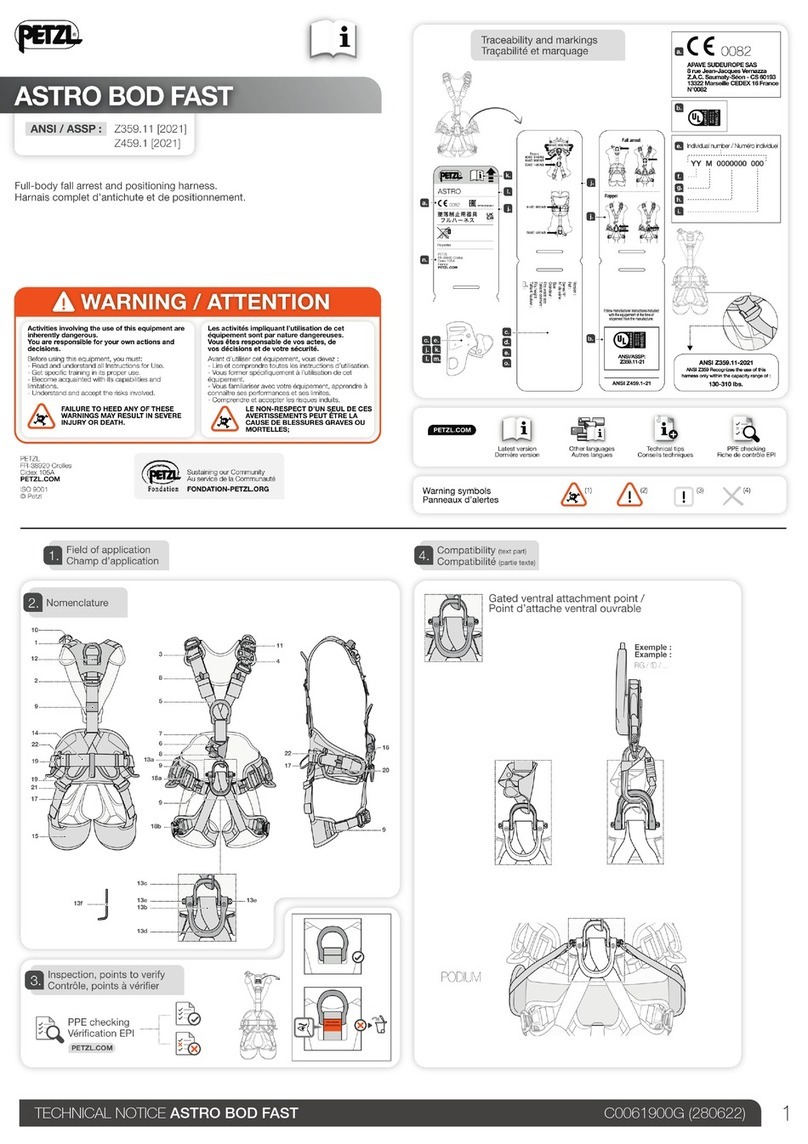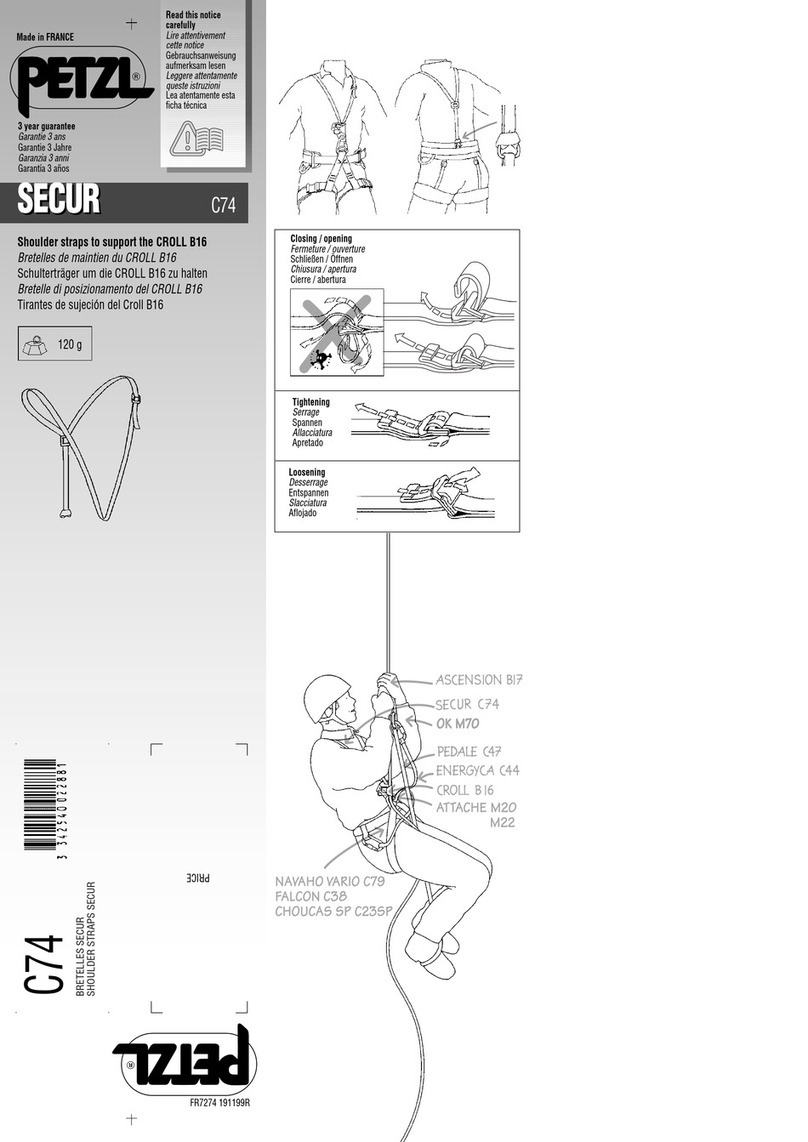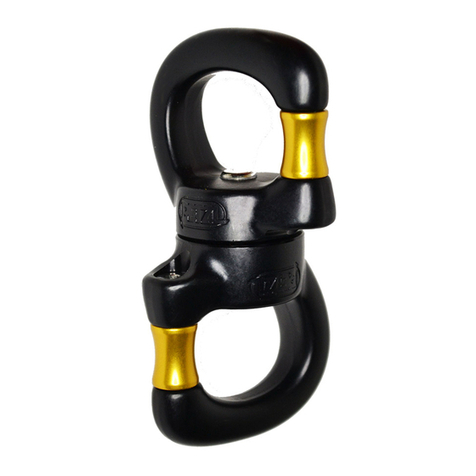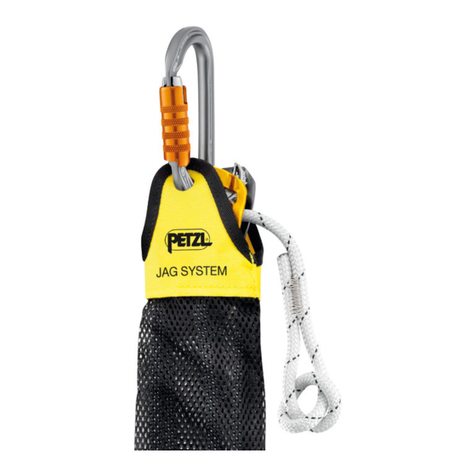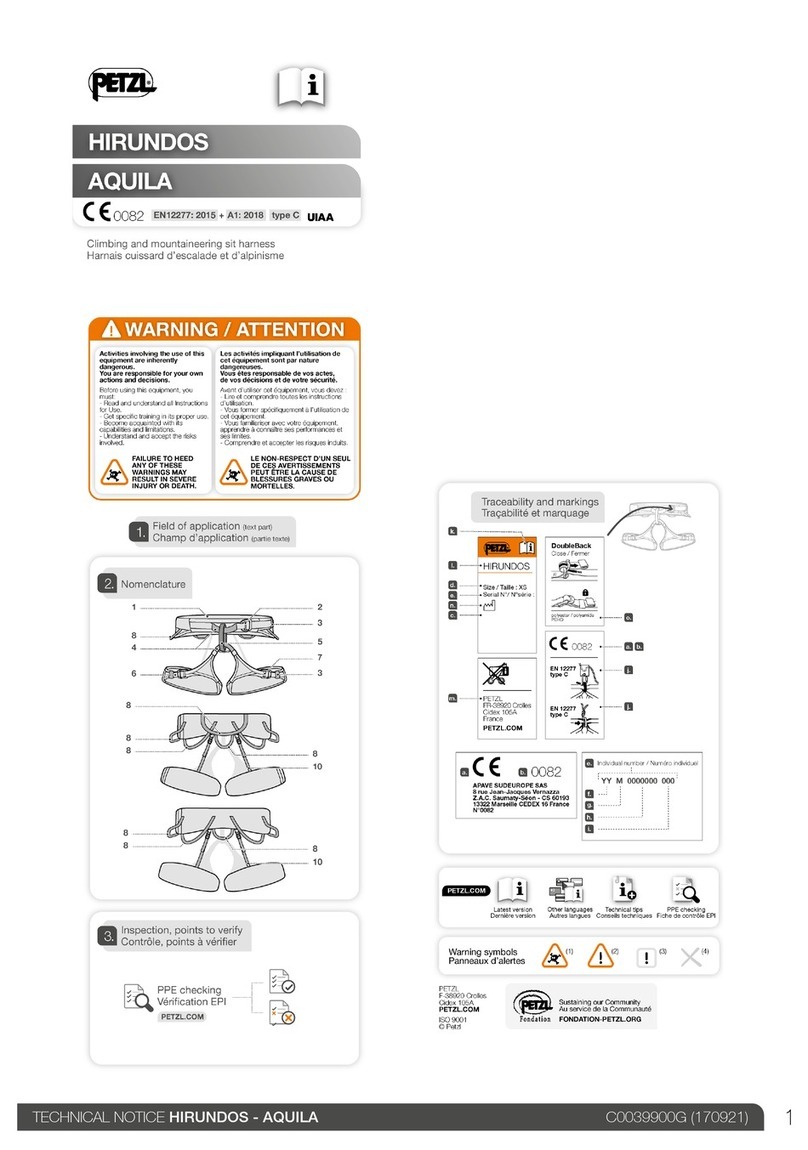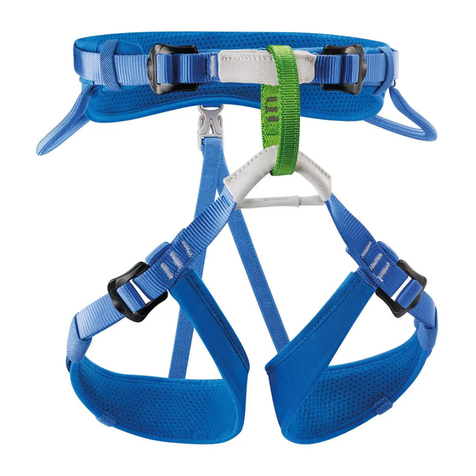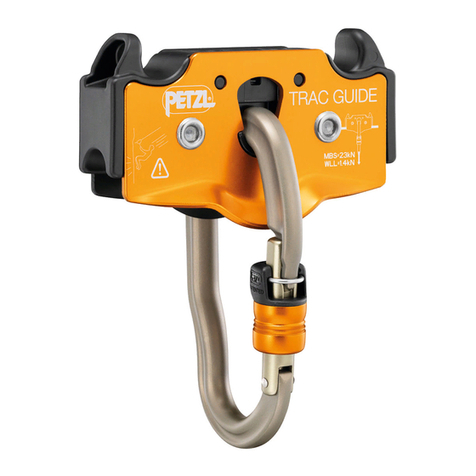
DEUTSCH
Legende
(1) Zentrale Aufhängeöse EN 358, (2) Seitliche
Aufhängeösen am Hüftgurt EN 358, (3) Seitliche
Aufhängeösen Hüftgurt/Sitzbrett EN 358,
(4) Verlagerte sternale Auffangöse EN 361, (5) DoubleBack-
Einstellschnalle, (6) Schultergurte,
(7) Beinschlaufen, (8) Hüftgurt zur Positionierung, (9)
Sitzbrett, (10) Durchführung, (11) Befestigungssystem für
ventrale Seilklemme, (12) Verbindungselement ATTACHE
+ Seilklemme CROLL (als Option), (13) Schlaufen für
Werkzeug, (14) Materialschlaufe, (15) Materialschlaufe für
schweres Material, (16) Verstellbare Elastikbänder.
Kontrolle, zu prüfende Punkte
Vor jeder Benutzung Gurtbänder im Bereich der
Aufhängeösen und der Einstellschnallen kontrollieren sowie
die Sicherheitsnähte prüfen.`Auf Einschnitte, Verschleiß
und Schäden aufgrund der Benutzung, der Hitze, der
Chemikalien usw. achten (dabei besonderes Augenmerk auf
durchtrennte oder zerrissene Fäden legen). Schnallen auf
einwandfreie Gängigkeit prüfen.
Gebrauchsanweisung
Prüfen, ob der Gurt kompatibel mit den anderen
Bestandteilen des Auffangsystems oder mit dem
Arbeitsplatz-positionierungssystem (Falldämpfer,
Verbindungsmittel, Verbindungselement) ist.
Der Anschlagpunkt des Systems sollte sich möglichst
oberhalb der Position des Nutzers benden. Er muß den
Anforderungen gemäß der Norm EN 795 entsprechen.
Darstellung 1. Anlegen des Gurtes.
Zustand des Gurtes: Beinschlaufen geöffnet.
a/b) Schulterriemen auseinanderhalten, Gurt am Hüftgurt
greifen und mit den Füßen hineinschlüpfen.
c) Hüftgurt durch Ziehen an den Gurtbändern des Hüftgurts
einstellen. Gurtbänder ordentlich in den hierfür
vorgesehenen Durchführungen verstauen.
d) Schultergurte nacheinander anlegen.
e) Diagonale Gurtbänder zur Verbindung von Hüftgurt
und Sitzteil einstellen.
Achtung: Bei Arbeiten am vertikalen Seil Hüftgurt durch
maximalen Zug an den diagonalen Gurtbändern zur
Verbindung von Hüftgurt und Sitzteil nach unten bringen.
f) Schultergurte einstellen.
g) Schnallen an den Beinschlaufen schließen.
Anmerkung: Der Nutzer sollte mit seiner Ausrüstung
Bewegungen und einen Test im aufgehängten Zustand
durchführen, um sicher zu sein, daß sie seiner Körpergröße
entsprechend eingestellt ist und den nötigen Komfort für
den zu erwartenden Einsatz bietet.
Darstellung 2. Verwendung als Auffanggurt
Nehmen Sie die auf dem Rücken bendliche verlagerte
sternale Auffangöse durch Ziehen des vornliegenden
Gurtbandes vom Klettverschluß ab. Befestigen Sie ihr
Auffangsystem und plazieren Sie anschließend die sternale
Auffangöse wieder am Klettverschluß auf dem Rücken.
Prüfen Sie, ob die technischen Eigenschaften des
beweglichen Auffangsystems (Fallhöhe) mit der verlagerten
sternalen Auffangöse kompatibel sind .
Darstellung 3. Verwendung bei der
Arbeitsplatzpositionierung
A. Zentrale Aufhängung.
B. Seitliche Aufhängung am Hüftgurt.
C. Seitliche Aufhängung am Hüftgurt und am Sitzbrett.
So können Sie die Sitzposition einstellen: zur vertikalen
Positionierung mit Hüftgurt/Sitzbrett durch Verkürzen der
Gurtbänder der seitlichen Aufhängeösen, oder zur
Positionierung an Schrägen Flächen mit Beinunterstützung
durch Verlängerung dieser Gurtbänder.
Sie können diese 3 Systeme kombinieren.
Diese Aufhängeösen dürfen nur zur Befestigung an einem
Arbeitsplatzpositionierungssystem (maximale Fallhöhe:
0,5 m) und niemals an einem Auffangsystem verwendet
werden.
Darstellung 4. Wiederaufstieg am Seil.
Die Aufhängeösen des Befestigungssystems (11) sind
der Befestigung der ventralen Seilklemme vorbehalten.
Sie müssen unbedingt mit einem an der verlagerten
sternalen Auffangöse befestigten Auffangsystem verbunden
sein.
A. Ventrale Seilklemme mit Hilfe eines
Verbindungselementes EN 362 an den beiden
Befestigungspunkten xieren (Verschluß zeigt nach unten).
Gurtband des Befestigungssystems für die ventrale
Seilklemme durch die obere Öffnung der Seilklemme
führen und in die Schnalle einfädeln.
B. An den diagonalen Gurtbändern zur Verbindung von
Hüftgurt und Sitzbrett ziehen, um die ventrale Seilklemme
in die niedrigste Position zu bringen. Sobald man am Seil
hängt, Schultergurte fest anziehen.
Allgemeine information
1. Achtung: Gründliche Ausbildung ist vor
Verwendung unbedingt notwendig
Lesen Sie die Gebrauchsanweisung von diesem Produkt
sorgfältig durch. Sie zeigt die verschiedenen Anwendungen
dieses Produktes. Nur die dargestellten, nicht
durchgestrichenen Verwendungstechniken sind erlaubt.
Jede andere Verwendung ist verboten: Lebensgefahr. Einige
Beispiele von Mißbrauch und verbotener Verwendung sind
ebenfalls angeführt (in durchgestrichenen Zeichnungen
oder mit Totenkopf-Symbol).
Eine Vielzahl von anderen falschen Verwendungen existiert,
deshalb ist es uns weder möglich sie aufzuzählen noch
vorzustellen. Im Zweifelsfall oder bei
Verständnisschwierigkeit, wenden Sie sich bitte an PETZL.
Aktivitäten in der Höhe sind gefährlich und können
bedrohliche Verletzungen hervorrufen, sogar zum Tode
führen. Das Erlernen der entsprechenden Techniken und
der Sicherheitsmaßnahmen liegen in Ihrer eigenen
Verantwortung.
Sie selbst übernehmen alle Risiken und die Haftung
für jede Art von Schäden, Verletzung oder Tod, die
durch falsche Verwendung unserer Produkte in jeglicher
Art und Weise hervorgerufen werden können. Wenn Sie
diese Verantwortung und dieses Risiko nicht übernehmen
können, dann verwenden Sie dieses Material nicht.
2. Verwendung
Nur ausgebildete Personen dürfen dieses Produkt
verwenden. Ist dies nicht der Fall, muß der Verwender unter
dauernder Sichtkontrolle einer ausgebildeten Person stehen.
Persönliche Schutzausrüstung (PSA) darf nur in Verbindung
mit Energie aufnehmenden Elementen verwendet werden
(z.B. dynamisches Seil oder Falldämpfer).Versichern Sie
sich, daß dieses Produkt mit den anderen Teilen Ihrer
Ausrüstung kompatibel ist.
Um die Lebensdauer dieses Produktes zu verlängern,
müssen Sie es sorgfältig transportieren und sachgemäß
verwenden. Vermeiden Sie harte Schläge oder Stöße
sowie Abrieb an rauhen Oberächen oder scharfen Kanten.
Bevor dieses Produkt verwendet wird, muß sich der
Benutzer über mögliche notwendige Rettungsaktionen
informiert haben.
3. Sicherheit = Kontrolle
Zögern Sie nicht, ein Produkt, das Spuren von Abnutzung
zeigt, welche seine Bruchfestigkeit beeinussen können,
auszusondern. Für Ihre Sicherheit empfehlen wir Ihnen, sich
einen 3-Stufen-Kontrollplan anzueignen:
- vor und nach jedem Gebrauch ist es notwendig,
den Zustand des Produktes zu überprüfen.
- während des Gebrauchs ist es wichtig, regelmäßig den
Zustand des Produktes und seine Verbindung mit den
anderen Teilen des Systems zu kontrollieren.
- regelmäßig muß eine genauere Prüfung durch einen
kompetenten Prüfer durchgeführt werden: ungefähr alle
3 Monate bei textilen Produkten und Helmen, ungefähr
jährlich bei Produkten aus Metall.
Für eine bessere Sicherheit und bessere Kontrolle Ihrer
Ausrüstung empfehlen wir Ihnen, sich eine Wartungsliste
für jedes Produkt anzulegen.
Es ist vorzuziehen, jedem Anwender von P.S.A., wie
Helme, Falldämpfer oder textile Produkte, sein eigenes
Ausrüstungsset persönlich zuzuteilen, um eine bessere
Kontrolle zu gewährleisten. Auf der anderen Seite ist
es nicht notwendig, einem einzelnen Benützer persönlich
Ausrüstungsgegenstände aus Metall oder Bohrhaken
zuzuteilen.
4. Großer Sturz und Belastung
Nach einem großen Sturz oder einer großen Belastung
(Absturz des Produktes oder Einwirkung auf das Produkt)
darf dieses Produkt nicht mehr benutzt werden. Verformung
oder innere, nicht erkennbare Risse können seine Festigkeit
und Funktion vermindern. Scheuen Sie sich nicht, im
Zweifelsfall Kontakt mit PETZL aufzunehmen.
5. Lebenszeit = Lagerungszeit + Gebrauchszeit
Lagerungszeit (unter günstigen Bedingungen):
Helme, Gurte, Bandschlingen und Leinen: 5 Jahr
Metallprodukte: unbegrenzt
Maximale Gebrauchszeit (ohne die Abnützung zu
berücksichtigen):
Helme und Gurte: 5 Jahre
Bandschlingen und Leinen: 3 Jahre
Metallprodukte: unbegrenzt
Die Einsatzzeit hängt von der Intensität des Gebrauches
ab. Es ist schwierig eine genaue Lebenszeit anzugeben,
weil diese von den Umwelteinüssen abhängt, denen
der Gegenstand ausgesetzt ist. Bestimmte Umwelteinüsse
erhöhen erheblich die Abnutzung: Salzwasser oder sandige
Umgebungen, oder Chemikalien. Jedoch können Abnutzung
oder Schaden beim ersten Gebrauch auftreten, wodurch
die Lebenszeit des Produktes auf diesen einen Gebrauch
reduziert wird. Bandschlingen und Leinen halten aufgrund
der starken Beanspruchung durchschnittlich 6 Monate bei
häugem Gebrauch, 12 Monate bei normalem Gebrauch
und maximal 3 Jahre bei gelegentlichem Gebrauch.
6. PETZL Garantie 3 Jahre
Auf dieses Produkt werden 3 Jahre Garantie für Material-
und Herstellungsfehler gewährt. Normale Abnutzung,
Verschleißerscheinungen, Veränderungen, Überarbeitungen
sowie falsche Lagerung sind von der Garantie
ausgeschlossen. Ebenso von der Garantie ausgeschlossen
sind Schäden aufgrund von Unfällen, Nachlässigkeiten
und aufgrund von Verwendungen, für die das Produkt
nicht vorgesehen ist.
PETZL übernimmt keine Haftung für direkte, indirekte
und unfallbedingte Folgen oder jegliche andere Art von
Schäden, die als Folge oder aufgrund der Verwendung
seiner Produkte entstanden sind.





